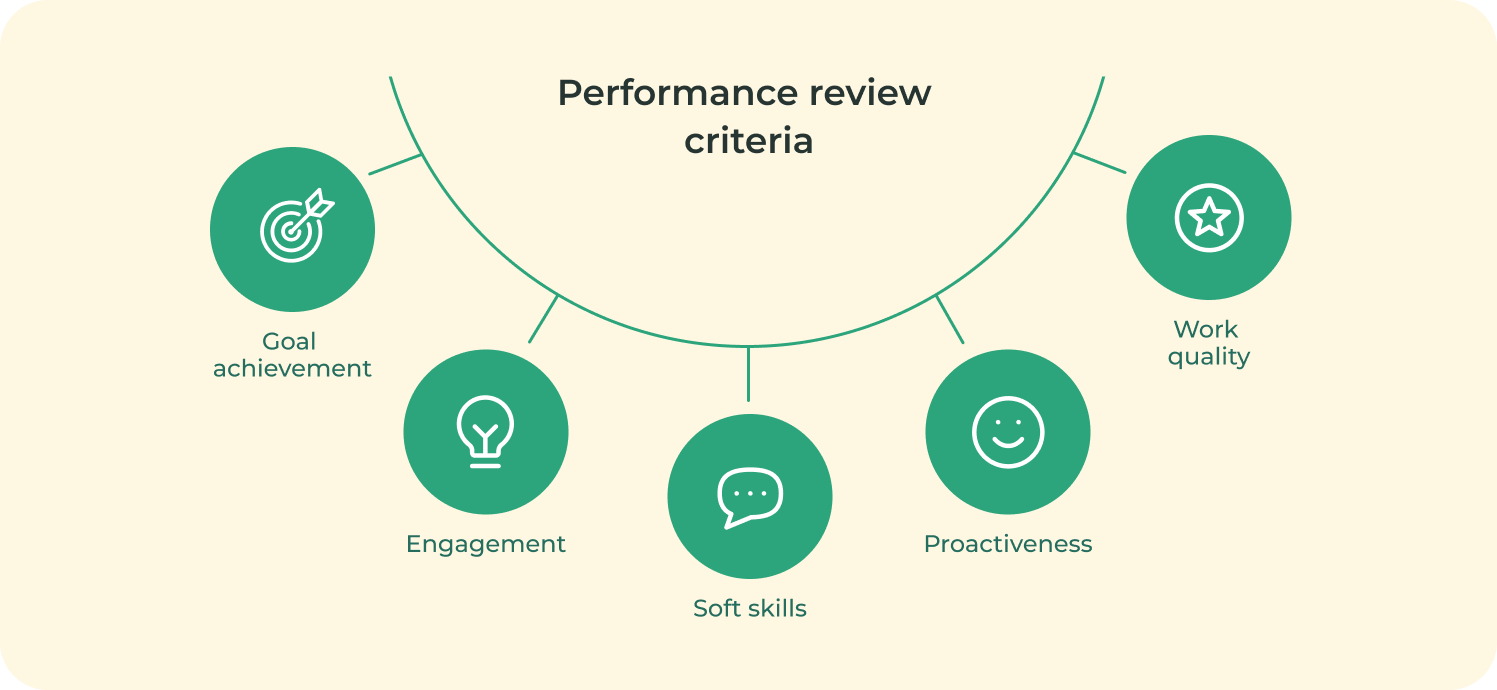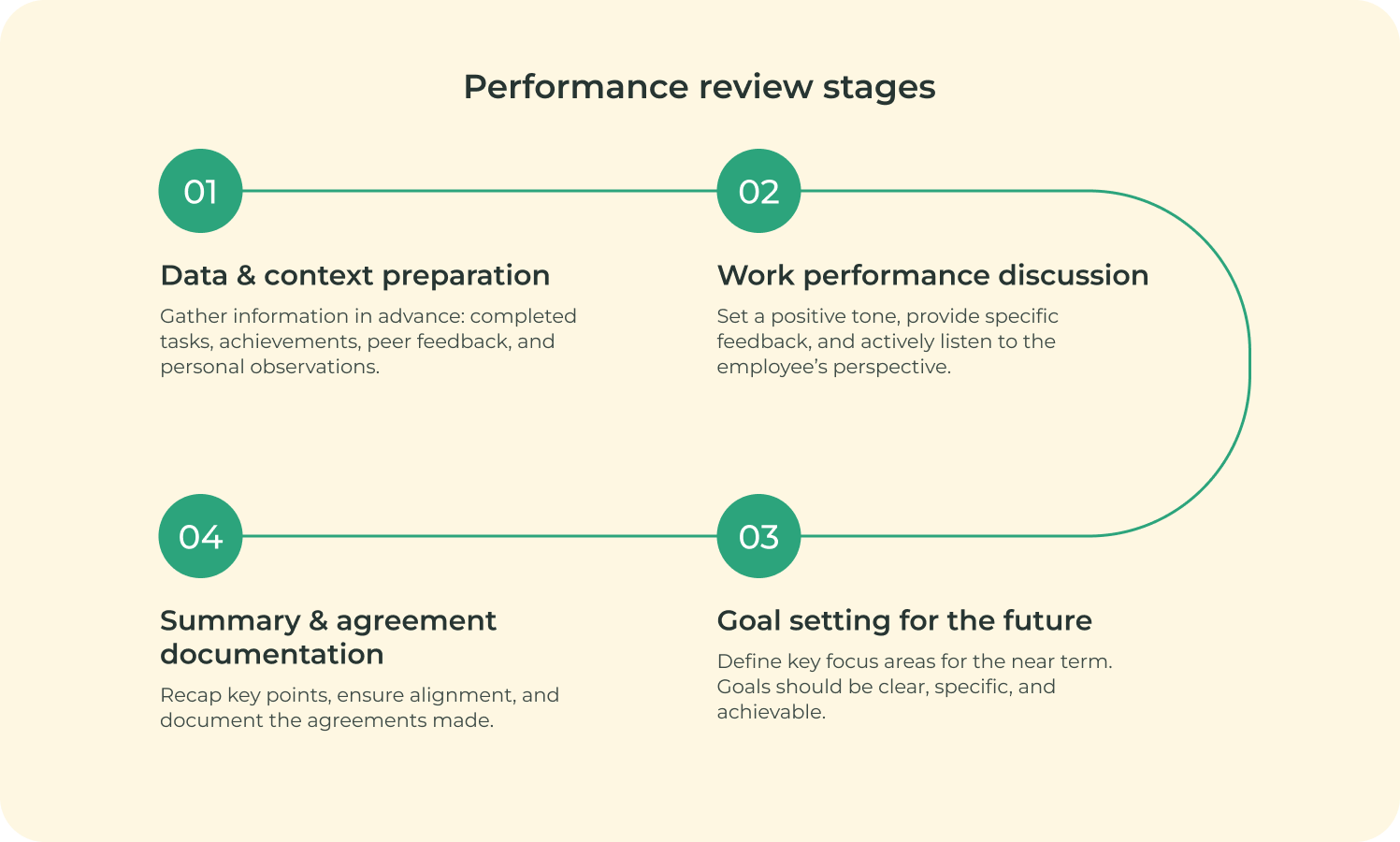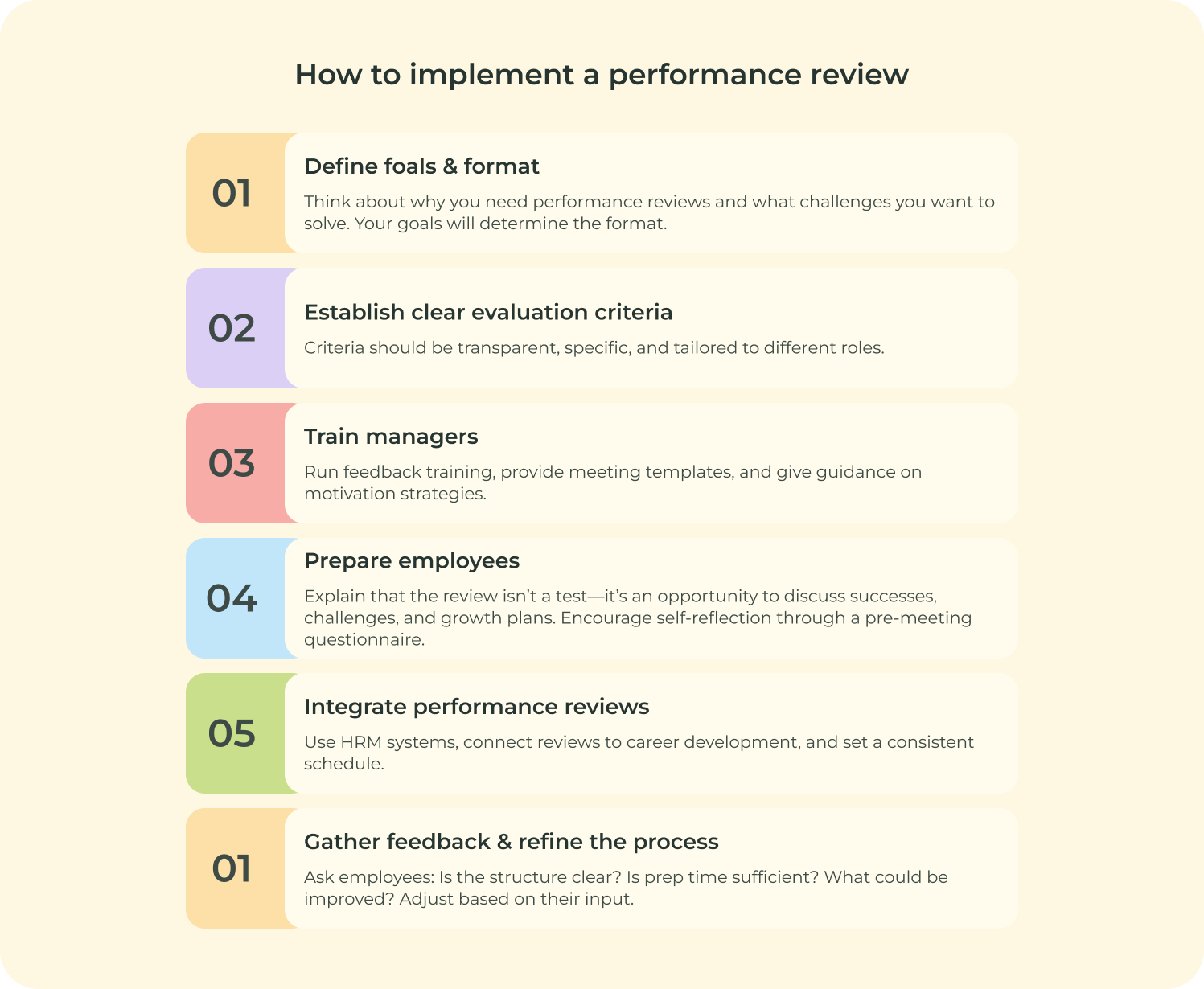and what we believe
Performance review: a practical guide to employee evaluation

Managers and HR teams often face a tough challenge: how do you fairly assess employee performance while keeping the team motivated? Traditional evaluation methods tend to fall short. They don’t always capture individual contributions accurately, and without clear, transparent feedback, employees can start feeling disengaged or even undervalued.
That’s where performance reviews come in — not as another box to check, but as a real tool for growth. When done right, they help uncover hidden roadblocks, set clear goals, and create an open, trust-based dialogue between employees and leadership.
So, how do you structure a performance review that actually works? Let’s break it down into something practical, effective, and genuinely beneficial for your team.
What is a performance review?
A performance review isn’t just another scheduled meeting where employees and managers go through checklists and performance metrics. At its core, it’s a conversation — a chance to talk openly about what’s working, what’s not, and what could be better. It’s a moment to step back from the daily grind and focus on growth, both personal and professional.
The real goal? To support employees and help them improve — not just to point out gaps but to offer guidance on how to close them.
Imagine a sales manager who’s a pro at building client relationships but consistently forgets to update the CRM. The team ends up chasing missing data, wasting time, and getting frustrated. A well-run performance review won’t scold them for inefficiency — it’s about spotting the issue together and finding a fix. Fast-forward a few months, and this same manager could be the one setting the gold standard for CRM best practices.
What makes performance review different from traditional evaluations? It’s not about ticking boxes or filling out generic surveys. It’s about real dialogue. It’s a space where employees and managers align on progress, ambitions, and future goals. Employees get a clearer vision of where they’re headed, and managers get the insights they need to build a team that’s engaged, motivated, and ready to perform at their best.
Why bother with performance reviews?
First off, it gives clarity. It’s a chance to step back and see the bigger picture — who’s thriving, who’s struggling, and why. Maybe your top analyst is delivering great results but keeps complaining about burnout. A quick chat might reveal the real issue: their workload is unevenly distributed. A small tweak — delegating tasks more effectively — could make their life easier while boosting overall efficiency.
Second, it drives engagement. Employees want to know their work matters. When they see their efforts are recognized, they’re more invested in what they do. Take a developer who’s great at coding but wants a seat at the table when discussing technical decisions. A well-timed performance review can open that door, giving them the involvement they crave and making them more motivated than ever.
Third, it helps catch problems before they spiral. Sometimes, employees don’t speak up about their struggles because they don’t know when or how to bring them up. A review provides that safe space. Imagine a designer who’s been quietly dealing with an outdated laptop that slows down their workflow. No one knew until they finally mentioned it in a review. A quick fix later, and their productivity (and job satisfaction) skyrockets.
And finally, it’s about growth for both employees and the business. Performance reviews help align personal ambitions with company goals. If someone’s aiming for leadership and the company needs a new department head, regular conversations can ensure the right person is ready when the opportunity arises.
Who runs a performance review?
Typically, a performance review is led by the employee’s direct manager — the person who sees their work up close, knows their strengths, and understands where they need to grow. But in some companies, HR professionals step in to help structure the process and track progress over time.
The key to making these meetings work? Honest, two-way communication. It’s all about the employee being open about their wins, struggles, and aspirations. A review where one side just nods along isn’t a review at all. It’s a wasted opportunity.
In some cases, colleagues or even cross-departmental leaders might join the conversation, especially when their input is crucial to evaluating performance. Regardless of who’s involved, the real magic happens when both sides come to the table ready to listen, reflect, and make meaningful improvements.
Streamline your performance reviews with HRsync’s HRM system
Never lose track of performance reviews, prepare the right questions in advance, and make the process as effective as possible — all in one place.
What criteria should you use for performance reviews?
A performance review is only useful if you know what you’re evaluating. Clear, well-defined criteria give employees direction, help them focus on areas for growth, and ensure their efforts align with company goals.

One of the key factors to assess is goal achievement. For a sales manager, this could mean meeting their quota, while for a marketer, it might be driving a specific percentage increase in traffic or lead generation. The important part? Goals should be realistic and agreed upon in advance — otherwise, they’re just wishful thinking.
Next up: quality of work. It’s not just about hitting targets but how tasks are completed. A developer’s success isn’t measured by the number of lines of code they write, but by the stability and efficiency of their work. An analyst isn’t judged just on the number of reports produced, but on how clear and actionable their insights are.
Then there are soft skills — often overlooked but critical. Communication, teamwork, and time management can make or break a team. A genius coder who can’t collaborate with colleagues? A ticking time bomb for team productivity.
And let’s not forget engagement and initiative. Employees who proactively suggest ideas, take responsibility, and invest in their own growth aren’t just valuable — they’re the ones who drive the company forward.
The golden rule? Adapt criteria to different roles. Too often, companies apply the same checklist to everyone, which is a surefire way to frustrate employees — especially those in creative roles where rigid KPIs don’t always make sense. Tailoring evaluation criteria ensures fairness, motivates employees, and helps set realistic, achievable development plans.
How does a performance review work?
A performance review isn’t just a sit-down chat — it’s a structured process with four key stages:

Now, let’s break each one down.
1. Preparation: setting the stage
Before the meeting, both the employee and manager need to gather relevant information — completed tasks, achievements, peer feedback, and personal observations. If you’re evaluating a sales manager, for example, this might include their sales performance data, client interactions, and deal closures.
It also helps to have employees fill out a short self-assessment. Questions like “What achievement are you most proud of this period?” or “What challenges held you back?” can give managers insight into their perspective. And remember, it’s not just about numbers — context matters. Maybe a dip in performance was due to external factors, and that should be factored into the discussion.
2. Discussion: looking back
The actual conversation should start on a positive note. A well-placed compliment — like recognizing a successfully completed project — can set a constructive tone and encourage open dialogue.
When giving feedback, be specific. Instead of saying “Your work could be better”, try something more direct: “Your report was delayed, which affected the project timeline. What do you think could have been done differently?” This frames the issue as a problem to solve together, rather than just pointing fingers.
And just as important — listen. Give employees the space to share what they found challenging or rewarding in their work.
3. Goal-setting: looking ahead
Now it’s time to set clear, measurable goals for the future. These could be performance-based (e.g., “Increase conversion rates by 10% next quarter”) or development-focused (e.g., “Complete a project management course and implement a task-tracking system”).
Also, discuss what support is needed — whether it’s extra training, mentorship, or a shift in workload. Goals without a plan to achieve them are just wishful thinking.
4. Wrap-up: making it stick
To make sure nothing gets lost, recap the key takeaways at the end: “Today, we discussed your achievements, key challenges, and set three goals for next quarter.” This ensures the employee leaves with a clear understanding of expectations.
Everything discussed should be documented so both parties can track progress and revisit commitments in the next review. Most importantly, follow through. If no action is taken during these meetings, employees will stop seeing them as valuable, and engagement will drop.
When performance reviews are structured, intentional, and followed up with real actions, they become a powerful tool for growth and motivation.
The right questions to ask in a performance review
Asking the right questions can turn an average review into a powerful tool for engagement and development.
Questions about achievements & results
These help recognize successes and understand what truly drives an employee:
- Which tasks or projects from this period do you think were the most valuable to the team or company? Why?
- If you could redo one of your recent projects, what would you do differently?
- When did you feel most productive and confident in your work? What contributed to that?
- Which project allowed you to apply your skills in the best way?
Questions about challenges & areas for improvement
These help identify obstacles and ways to overcome them:
- Were there any tasks that felt unnecessary or inefficient? What would you change?
- Which tools, resources, or processes do you find the hardest to work with?
- What aspects of your job cause the most stress or frustration? How can we address them?
Questions about growth & motivation
These reveal aspirations and how employees see their professional future:
- If you could take on a new project or responsibility, what would it be? Why?
- What skills or knowledge do you want to develop in the next six months?
- Imagine you had an extra day each week dedicated to self-improvement—how would you use it?
Questions about feedback & team dynamics
These help improve collaboration and assess leadership support:
- Is there anything in our team that’s holding you back from reaching your full potential?
- How would you rate teamwork and collaboration? What could be improved?
- Do you feel you receive enough feedback on your work? If not, what format would be more helpful?
- If you could suggest one improvement for our team’s workflow, what would it be?
How to integrate performance reviews into your workflow
The key here is clear structure, seamless integration, and buy-in from both managers and employees. Here’s how to make it work.

1. Define your goals & format
Before launching, ask yourself: Why are we doing this? What do you want to achieve?
- Do you need a structured way to measure employee performance?
- Are you focused on skills development and career growth?
- Do you want to build a culture of trust and open communication?
Your goals shape the format. If you’re tracking project progress, quarterly reviews make sense. If the focus is career development, biannual or annual reviews may be a better fit.
Also, decide who will be involved: just the manager and employee, or should HR specialists step in to help facilitate and track progress?
2. Set clear, fair evaluation criteria
A performance review should never feel like a mystery test. Employees need to know exactly what they’re being evaluated on.
Your criteria should be:
- Transparent: clearly communicated beforehand.
- Specific: tied to measurable factors (e.g., meeting KPIs, hitting deadlines, improving skills).
- Role-adjusted: engineers, marketers, and salespeople all have different success metrics.
- A sales team might be evaluated on quota achievement, customer interactions, and pipeline growth.
- An IT team might be measured by completed projects, code quality, and meeting deadlines.
The key? Aligning expectations upfront to ensure fair and constructive reviews.
3. Train your managers
- Feedback training: teach them to provide constructive criticism without discouraging employees.
- Meeting templates: give them structured question frameworks and discussion formats.
- Motivation strategies: show them how to focus on growth rather than just pointing out flaws.
With proper training, managers shift from simply listing mistakes to coaching employees on how to improve. This helps build stronger, more motivated teams in the process.
4. Prepare your employees
For employees, performance reviews can feel intimidating, especially if they’re new to the process. Help ease the tension:
- Communicate the purpose: hold an intro session or send a guide explaining that reviews are about growth, not punishment.
- Clarify the format: explain how the meeting will go so they know what to expect.
- Encourage preparation: provide a self-assessment questionnaire to help employees gather their thoughts beforehand.
When employees see reviews as a tool for their development rather than just another corporate hoop to jump through, they’ll be more engaged and open in the process.
By laying the groundwork before launching performance reviews, you ensure they become a meaningful, growth-focused ritual.
Get ready for performance reviews in advance
An HRM system helps you structure reviews, stay organized, and make the process more productive — without missing any key details.
5. Make performance reviews a seamless part of your company culture
For performance reviews to truly work, they can’t exist in a vacuum. They need to be woven into the company’s daily workflow and HR processes.
- Use HRM systems: such tools help schedule reviews, log conversations, track progress, and set goals, making the process smoother for everyone.
- Connect reviews to career growth: make performance discussions count by using them to guide promotions, salary decisions, and training opportunities. Employees will engage more when they see real outcomes.
- Stick to a schedule: decide on a cadence — quarterly, biannual, or annual — and stay consistent. When reviews become part of the routine rather than a one-off event, they carry more weight.
6. Gather feedback & keep improving
- Is the review structure clear?
- Is there enough time to prepare and discuss everything that matters?
- What challenges are coming up? What could be improved?
- Do employees feel reviews are helping them grow in their careers?
Final thoughts
A performance review is a great opportunity to truly connect with employees, celebrate wins, and address challenges together.
Behind the spreadsheets and KPI reports are real people — with ideas, ambitions, and sometimes, quirky work habits. A good performance review helps bring out the best in them.
To make it work, remember to:
- Define clear goals and the right format.
- Set transparent, role-specific evaluation criteria.
- Prepare employees and train managers to lead productive conversations.
- Make reviews an integral part of career development.
- Ask the right questions to spark meaningful discussions.
- Continuously refine the process based on feedback.
- Ensure every meeting leads to real actions.
Get a free consultation and learn how HRsync’s turnkey solutions can optimize your company’s HR processes.
